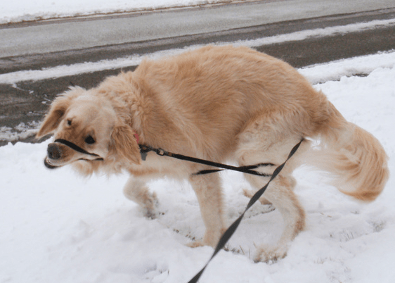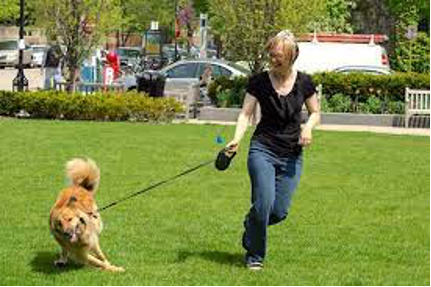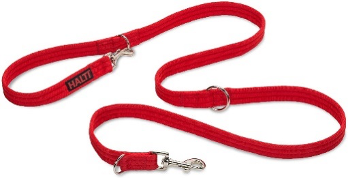01/10/2021 - Equipment for puppy and dog training
Flexi leads are a common choice for many dog owners and we can see why! The ease of a short and long lead in one, no trailing lines to gather up or pick up mud and a sleek, ergonomic handle.
So why are they the nemesis of most pet professionals? How does our choice of lead affect us, our dogs and our training?
Unfortunately, these attractive products come with numerous downsides and risks…
Retractable leads sound like the perfect lead for keeping our dogs under control and safe while allowing us to let them roam and run when there’s space to do so – but these features are what make them so potentially dangerous…

Locking Feature: Flexi leads come with a handy button to lock the lead at a certain length or allow our dogs to roam further from us. However, this locking mechanism can fail and leave us in a potentially dangerous situation when our dogs continue running towards the road or the aggressive dog.
This can also pose a risk to humans – there have been cases of locking mechanisms failing and the extended lead recoil at speed, with the end of the line whipping wildly. In one case, the clasp of the lead hit the user in the eye and caused serious damage.

The Handle: The iconic handle of a retractable lead is one of the product’s biggest selling points, with manufacturers stressing the one-handed braking system and ergonomic design; but these, too, are a hazard. The bulky, plastic handle is much easier to lose grip on than a traditional lead – especially when paired with a long line, allowing our dogs to pick up some speed before suddenly hitting the end with force. When these handles are dropped, the retractable design means the lead handle quickly begins clattering after the running dog – this can often frighten dogs and cause them to panic and bolt, making an already precarious situation even worse.
Neck Injuries: Flexible leads are often used attached to a dog’s regular flat collar. No long line – flexible or not – should be used without a proper fitted and comfortable harness, but retractable leads are particularly problematic. With no way to slow a running dog down other than to suddenly lock the lead or allow them to hit the end of it, these leads can cause serious neck injuries from the sudden force applied – that’s if the handler manages to keep hold of the lead!
Road Safety: The convenience of a flexi lead means many users enjoy giving their dogs the freedom to walk at some distance behind or in front of them along footpaths, or to roam and sniff grass verges. While we fully encourage dog owners to allow their dogs to stop and sniff things and to walk at their own pace, doing so by allowing distance between ourselves and our dogs with a flexi lead is an incredibly dangerous way to do this. Not only have dogs been known to run into traffic when the locking mechanism has failed, a sudden distraction on the other side of the road can cause a dog to change direction quickly. With our dogs at such a distance from us, we have absolutely no hope of stopping them before they have stepped off the curb. Much better to just slow down ourselves and enjoy a leisurely stroll with our dogs!

We know that loose lead walking is a top priority for almost every dog owner. If this is true for you, then retractable leads are your nemesis, too! Designed to unspool easily when tension is applied, a dog quickly learns that applying pressure to the lead (ie pulling!) is the best way to get wherever they want to go!
Every time your dog takes a step forward, and the lead unspools, your dog is being rewarded for continuing to walk while they can feel tension on the lead. This is the exact opposite of what we want them to learn when loose lead walking is our goal!

When working on loose lead walking, we want our dogs to know that good things happen when there is NO tension on the lead. Good things can be treats from us or access to their favourite sniffy patch or even just continuing on their walk! The only way to achieve loose lead walking with a retractable lead, is to lock it at a specific length so we can reward our dog when the lead is slack – this completely negates the “benefits” of a retractable lead and, given all the additional safety risks, and how cumbersome these handles make it for us to train our dogs (ironically, the “single-handed” design actually leaves us with one hand less for delivering treats or cueing our dogs etc than a regular lead, which is both less bulky and allows us to loop it over our arm if needed), why would we ever choose to use one when working on loose lead walking?
If you truly want to teach your dog to walk nicely on the lead join our Puppy and dog training classes and accompanying lead masterclasses to learn all the skills needed to achieve your walking goals.
We know that none of you buy retractable leads with the intention of ignoring your dogs, but we’re all human! The convenience of simply walking at our own pace, while allowing our dogs to trot ahead or hang behind, make it so easy to fall into a habit of not paying close attention to what our dogs are doing while we are walking “with” them. Rather than teaching our dogs to stay engaged and listening to us – on a nice, loose lead – our dogs are effectively walking themselves. All too often, triggers (such as other animals) or hazards (such as joggers/cyclists sharing the path or things on the floor our dogs might eat) go unnoticed until too late.
We all have dogs because we love them and we know how much you all enjoy spending time with your dogs. So, stay present on their walks, stay close to them and be as engaged with them as we would like them to be with us!
So, what should you do with your flexi leads…? Well, our recommendation is:
PUT THEM IN THE BIN!
We recommend a good double-ended training lead – such as the one pictured. These comfortable leads are easy to hold, won’t cut into fingers or limbs, and you can adjust the length by using either of the three rings.
For distance work, we recommend a sturdy long line – these leads come in a variety of lengths and materials to suit your preferences and allow our dogs the extra freedom of a longer lead with no persistent tension. They are much more suitable for recall training as we can let them trail loosely so our dogs learn to recall to us even when they feel like they are “off lead.”

Important Note: We always recommend walking our dogs in a well fitted, comfortable harness – it is especially important when using any long line, that these are attached to a harness and not a collar. While it is much easier to slow our dogs down gradually with a traditional long line (vs a retractable lead), we still don’t want to risk our dogs reaching the end of the line at speed and receiving a nasty jolt to their necks!
Copyright © 2025 Best Behaviour Dog Training
Registered No. 12954178
Registered address: Poplar Hill, Stowmarket, Suffolk, IP14 2AX
Website design by Upshot Media Ltd